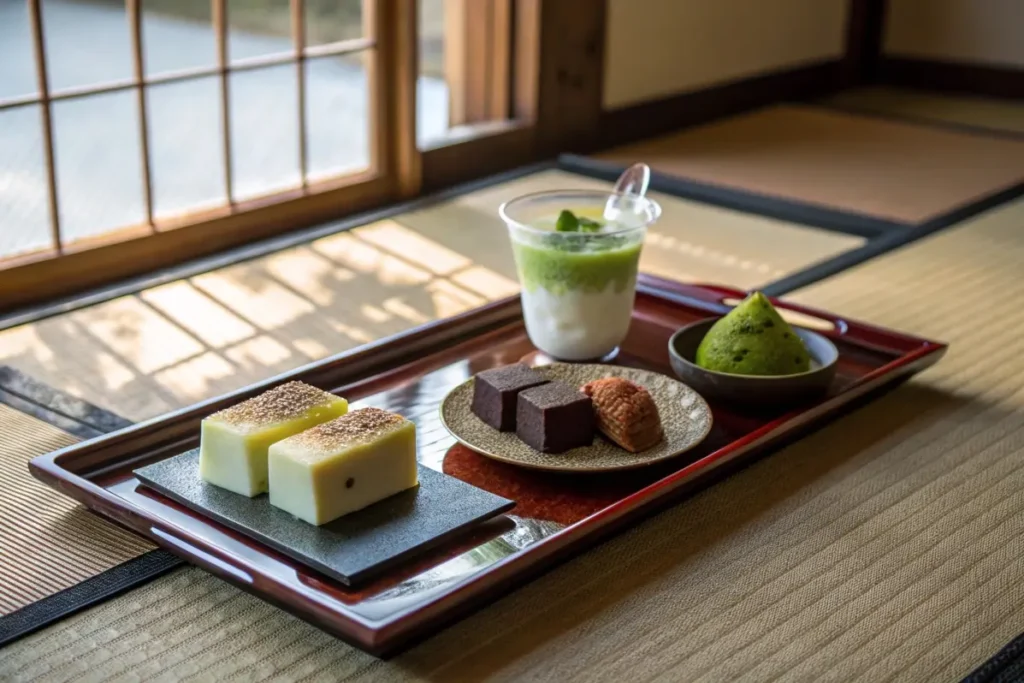Japanese desserts dazzle with artful presentation, subtle sweetness, and a deep connection to tradition. japanese desserts names like mochi, dorayaki, and daifuku may be familiar to sweet enthusiasts around the globe, but there’s a vast selection beyond these popular staples. From centuries-old wagashi—manju, yokan, anpan—to modern hybrids like matcha parfaits and souffle pancakes, each dessert tells a story of regional culture, seasonal awareness, and culinary craftsmanship.
What are popular Japanese desserts names ? Many revolve around mild sweeteners, natural ingredients, and minimalist elegance. Meanwhile, traditional sweets in Japan often involve rice flour, bean paste, and tea-inspired flavors that pair perfectly with green tea. What are the 9 common desserts? You’ll soon discover more than nine iconic treats as we highlight old favorites and trending newcomers. And if you’re curious about the name of Japanese jelly, we’ll dive into confections like kanten-based sweets—gelled desserts that enthrall the eye and palate alike.
In this guide, we’ll explore an array of japanese desserts names, revealing what makes them special, how to enjoy them, and even how to create them at home. If you’re already itching to bake or steam something tasty, check out our ever-growing collection at Japanese Dessert Recipes for step-by-step directions. Now, let’s take a close look at the main categories, ingredients, and traditions behind Japan’s most beloved sweet treats.
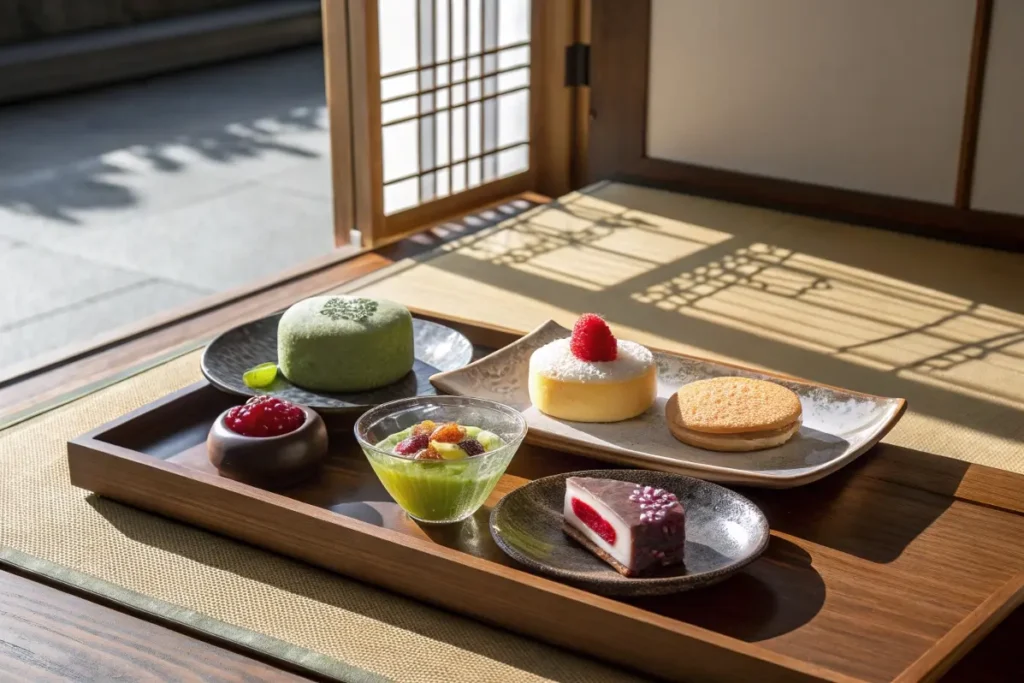
Table of Contents
1. Popular and Iconic Japanese Desserts Names
1.1 Mochi and Daifuku
Mochi
- A chewy rice cake made from pounded glutinous rice. Its mild flavor and sticky texture make it a blank canvas for sweet or savory adaptations.
- Eaten year-round, especially during celebrations like New Year’s, mochi can also star as a dessert base.
Daifuku
- A stuffed mochi version. Typically filled with anko (sweet red bean paste), though modern variations incorporate fruit (ichigo daifuku with strawberries) or whipped cream.
- The contrast between mochi’s subtle chew and sweet paste epitomizes Japanese dessert style.
1.2 Dorayaki and Taiyaki
Dorayaki
- Essentially two small pancakes sandwiching an anko filling. Beloved by kids, referenced in anime, and easy to find in conbini (convenience stores).
- Some versions add chestnuts, sweet potato puree, or custard, catering to evolving tastes.
Taiyaki
- A fish-shaped waffle typically stuffed with anko, custard, or chocolate. Street vendors cook them in fish-mold pans, resulting in a crisp exterior with a warm, sweet filling.
- The fish shape (tai) symbolizes good luck in Japanese culture, so it also sometimes features at festivals or celebratory events.
1.3 Matcha and Tea-Infused Sweets
Matcha Roll Cake
- A light, spongy cake tinted green with matcha, filled with whipped cream or anko. This swirl embodies the marriage of Japanese tea tradition and Western pastry technique.
- Perfectly balanced to avoid overwhelming bitterness or excessive sugar.
Matcha Parfait
- A layered dessert in tall glasses—matcha ice cream or jelly, whipped cream, sweet beans, and mochi cubes. Loved by cafe-goers craving a visually striking, refreshing treat.
1.4 Jelly and Kanten Confections
Kanten Jelly
- Kanten (agar-agar) is a seaweed-derived gelling agent used in japanese desserts names like anmitsu or fruit-laden jelly cups.
- Offers a firmer, less elastic set than gelatin, appealing to those seeking vegetarian or health-friendly sweets.
Mizu Yokan
- A block-like jelly made of anko and agar, resulting in a mildly sweet, smooth treat. Often chilled in summer for a refreshing effect.
- Some freeze mizu yokan partially, enjoying it slushy or half-thawed for a unique mouthfeel.
1.5 Pancakes and Cheesecakes
Souffle Pancakes
- Ultra-fluffy, jiggly pancakes that soared in popularity on social media. Their airy texture contrasts typical Western flapjacks.
- Often lightly sweetened, accompanied by fruit, whipped cream, or a drizzle of syrup.
Japanese Cheesecake
- Featherlight, cotton-soft style cheesecake. Less sugary and more “foamy” than dense Western versions. The hallmark is a gently sweet bite, often served in smaller wedges.
For detailed recipes of these iconic items, see our Traditional Japanese Desserts Recipe page, which covers mochi, dorayaki, and more. From classic wagashi to fusion experiments, these sweets reflect centuries of craftsmanship alongside modern creativity. Whether you’re craving a pillowy pancake or a simple bean-filled pastry, the japanese desserts names above are just the tip of the sweet iceberg, revealing why so many global foodies fall in love with Japan’s dessert scene.
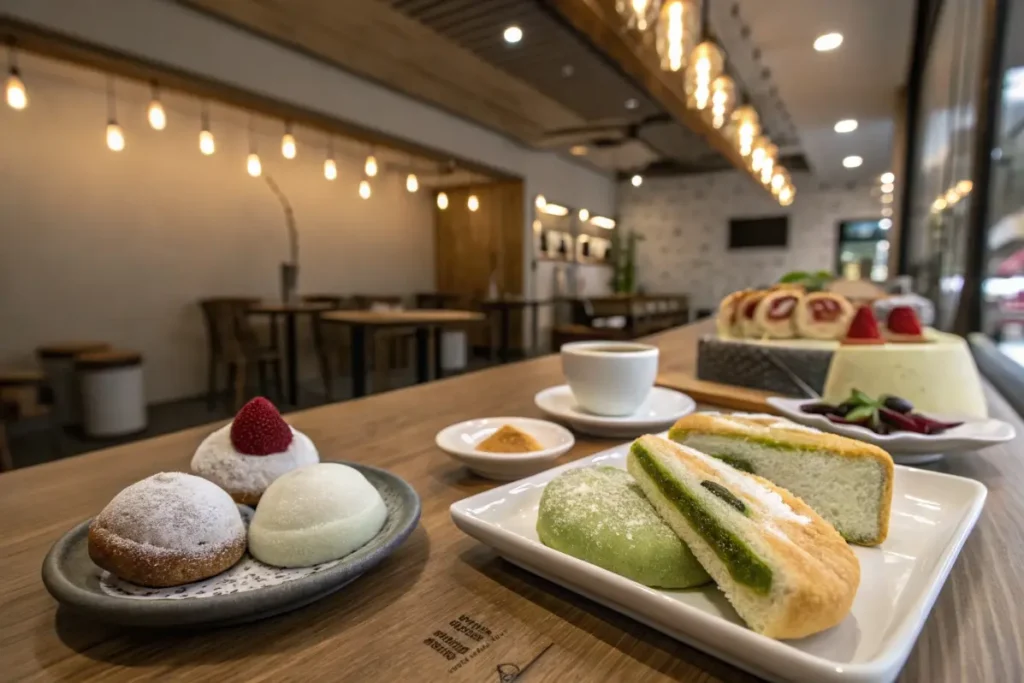
2. Key Traditional Sweets
2.1 Wagashi Fundamentals
Wagashi
- A broad term for traditional Japanese sweets often linked to tea ceremony practices. Composed of azuki bean paste, rice flour, agar, chestnuts, and seasonal fruits.
- Highlights minimal sugar, refined shapes, and small portions. These aesthetic creations frequently reflect nature, from flower-inspired designs to seasonal motifs.
2.2 Manju and Yokan
Manju
- Steamed buns typically stuffed with anko or other sweet fillings (like chestnut puree). The outside can be made from wheat flour or yam-based dough.
- Some manju styles are baked, resulting in a golden crust that complements the sweet, moist interior.
Yokan
- A firm block of agar-jellied sweet bean paste. Usually cut into slices for serving. Flavors vary—matcha yokan, chestnut yokan, or the summer-friendly mizu yokan (softer consistency with higher water content).
- In older times, yokan was a staple for travelers, as it had a relatively long shelf life without refrigeration.
2.3 Imagawayaki & Anpan
Imagawayaki
- Also called obanyaki in some regions, these are thick, round pancake buns with a hidden sweet core (commonly anko). Vendors cook them in cast-iron molds on street stalls.
- Crisp on the outside, fluffy inside, with melted bean paste for a comforting snack reminiscent of taiyaki but in a different shape.
Anpan
- A soft, fluffy bread roll brimming with anko. Created during the Meiji era by combining Western bread-making with Japanese sweet paste.
- Serves as a prime example of Japan’s ability to fuse foreign techniques with local flavors.
2.4 Wagashi’s Symbolic Relevance
Wagashi, including manju and yokan, hold ceremonial roles—wagashi shapes or designs frequently honor festivals or seasons. Pink-hued sweets for cherry blossom festivities, autumn leaves or chestnut-flavored sweets in fall, etc. The approach underscores Japan’s respect for nature’s changing cycles.
2.5 Enjoying Traditional Desserts with Tea
Most japanese desserts names in wagashi revolve around pairing with bitter or umami-rich beverages. Matcha or sencha tea’s slight bitterness offsets wagashi’s mild sweetness, letting each flavor shine. For novices, this pairing is a sensory delight—soft, sweet paste melding with warm, earthy tea.
Curious about vegetarian or vegan versions? Many wagashi are naturally free of animal products, relying on plant-based ingredients. You can also explore Japanese Vegan Recipes to see how beans, rice flours, and fruits can craft healthy sweets suiting all diets.
2.6 Regional Variations
- Kyoto: Known for elegant, artisanal wagashi, shaped like seasonal flowers.
- Tokyo: Home to dynamic pastry fusions, from castella to anko croissants.
- Nagasaki: Pride in castella sponge cake—a Portuguese influence refined over centuries.
From manju’s pillowy texture to yokan’s translucent sheen, each sweet captures a piece of Japan’s storied dessert legacy. The emphasis remains on natural flavors, moderate sugar, and a quiet beauty that merges seamlessly with daily rituals—especially the tea ceremony, anchored in mindful consumption. Wagashi, at its core, champions a balanced dessert experience, sweet enough to please but never cloying, always mindful of harmony between taste, texture, and aesthetic.
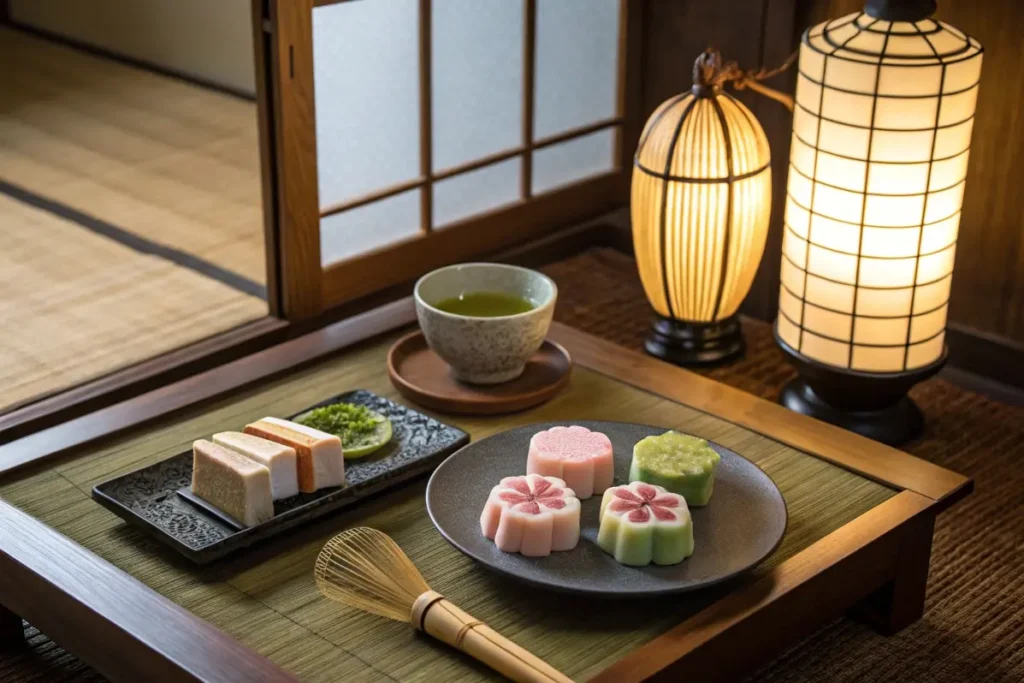
3. History and Context of Japanese Desserts Names
3.1 Early Rice and Bean Traditions
Rice cultivation has anchored Japanese cuisine for millennia. Thus, sweets derived from pounded rice (mochi) or sweet bean paste (azuki) emerged organically. Before refined sugar, desserts might rely on fruit sweetness, honey, or minimal sweeteners. Over centuries, these staples shaped classic japanese desserts names.
3.2 Edo Period and Sugar Influx
From the 17th to 19th century, sugar imports from China and the Ryukyu Kingdom made sweet-making more accessible. The Edo period saw wagashi artisans thrive, perfecting mochi, anko, and agar-based sweets for tea ceremonies or urban sweet shops. Many confections like yokan and manju flourished in Edo (now Tokyo) and Kyoto.
Tea Ceremony Influence: The elaborate tea ceremony (chanoyu) demanded small sweets to complement matcha’s bitterness. Confectioners created meticulously shaped wagashi reflecting seasonal flora or cultural symbols. These sweets, though small, carried significant aesthetic and symbolic weight.
3.3 Western Contact and Fusion
Post-1868 Meiji Restoration, Western pastries like sponge cakes (castella), bread (leading to anpan), and custards made their mark. Japanese pastry chefs merged imported techniques with local ingredients. As sugar production soared, japanese sweet food expanded from strictly wagashi to yōgashi (Western-style confections). Classics like an-pan or castella remain beloved examples of this synergy.
3.4 Showa to Modern Era
The Showa period (1926–1989) popularized conbini desserts—dorayaki or anko buns wrapped individually. Refrigeration and advanced baking tech gave rise to airy cheesecakes, matcha Swiss rolls, and even mochi donuts. Each generation reinterpreted tradition, birthing new japanese dessert recipes that catered to changing tastes and global influences.
21st Century Innovations: Contemporary patisseries regularly feature matcha tiramisu or sweet potato Mont Blanc. Café culture booms with fluffy soufflé pancakes or layered matcha parfaits. Social media fosters dessert trends, with Tokyo often at the vanguard. Despite these evolutions, core pillars—mild sugar, natural flavors, small portion sizes—endure.
3.5 Global Spread
As Japanese cuisine gained worldwide acclaim, so did its desserts. People worldwide recognized the delicate artistry of wagashi, the airy wonders of Japanese cheesecakes, or the novelty of mochi ice cream. International grocery aisles stock mochi flour, matcha powder, and anko paste, enabling home cooks to replicate favorites. Meanwhile, overseas restaurants and pastry shops brandish japanese desserts names to captivate local sweet-tooths.
For additional background on storied confections like dorayaki or taiyaki, check out our Japanese Dessert Recipes. The unstoppable blend of tradition, adaptation, and global interest keeps japanese desserts thriving—whether you prefer time-honored wagashi or inventive East-meets-West treats, there’s always something fresh to discover in Japan’s sweet landscape.
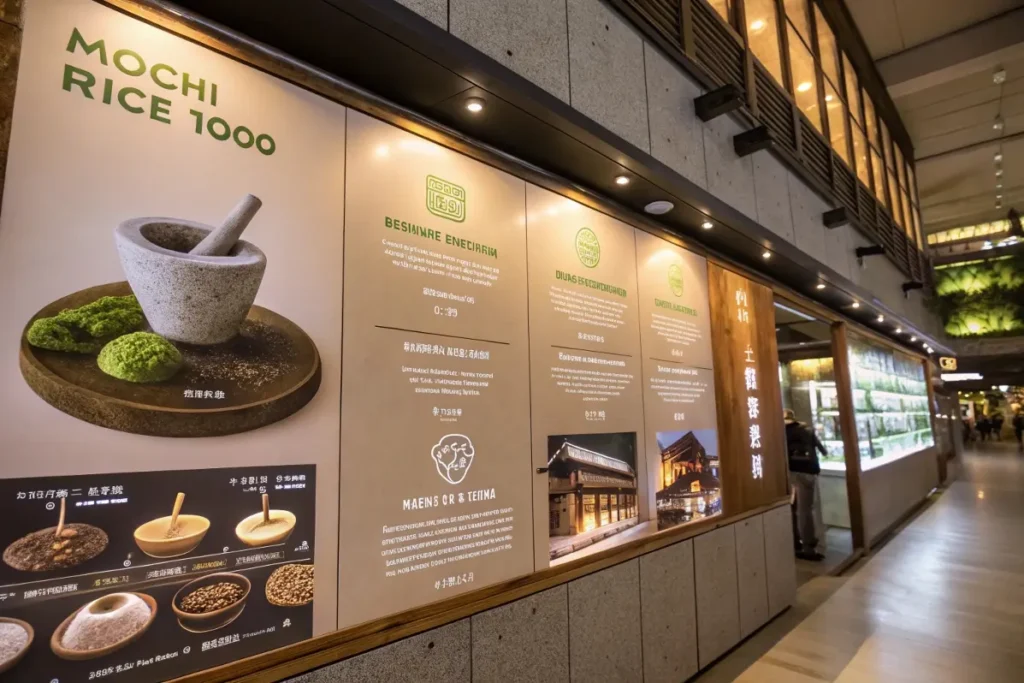
4. Practical Examples/Use Cases for Japanese Desserts Names
4.1 Home Baking and Entertaining
Scenario: Hosting a small gathering and want a unique dessert table.
- Approach: Offer a dessert flight of mochi (or daifuku) with strawberry filling, mini dorayaki pancakes, and a matcha roll cake slice.
- Benefit: Guests sample a variety of iconic japanese desserts names, each revealing a different texture—chewy mochi, fluffy pancake, airy sponge. Presentation remains minimal yet visually appealing.
4.2 Cafe or Bakery Additions
Scenario: A Western-style cafe aims to diversify with lighter, less sugary confections.
- Approach: Introduce a small selection of wagashi—like yokan slices or fruit-laden kanten jelly cups—beside your typical pastries. Market them as “delicate, tea-friendly sweets” for customers wanting a break from heavy buttercream.
- Result: Attract new clientele intrigued by East Asian flavors. Some might become regulars specifically seeking these lower-sugar, visually striking options.
4.3 Bento Boxes or Lunchtime Treats
Scenario: You need a sweet finishing touch for a bento lunch.
- Approach: Pack a single daifuku or a slice of yokan in a sealed container. The moderate size suits portion control, ensuring a sweet treat without sugar overload.
- Advantage: Japanese dessert portions are typically small. Their subtle sweetness pairs well with savory bento dishes, leaving you satisfied rather than weighed down.
4.4 Cultural Festivals and Events
Scenario: Organizing a Japanese cultural festival at a community center.
- Approach: Set up a mochi-making station or demonstration of taiyaki molds. Add an educational corner about wagashi, with free samples of anko-based manju or jelly squares.
- Goal: Attendees learn about japanese desserts names, tasting everything from mochi to fruit jelly. This interactive approach fosters an appreciation for the tradition and artistry behind each dessert.
For a robust meal preceding these sweets, consider referencing our Japanese Chicken Fried Rice Recipe as a savory highlight. Follow it with a daifuku or mochi, bridging the gap between comforting stir-fry flavors and the mild sweetness of Japanese confections. These practical use cases confirm how seamlessly japanese desserts names can integrate into everyday dining or special gatherings, merging taste, health, and cultural intrigue.
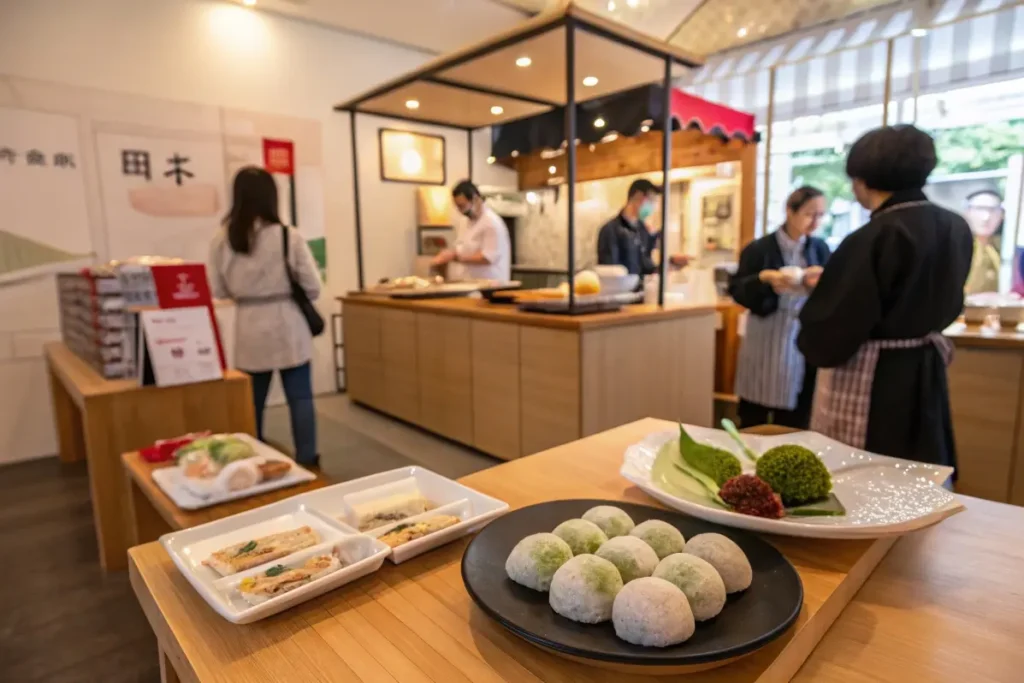
5. FAQs about Japanese Desserts Names
5.1 What are popular Japanese desserts names?
They range from mochi and daifuku to dorayaki, taiyaki, and matcha pastries. Creamy cheesecakes and airy soufflé pancakes also enjoy massive popularity. The variety covers everything from chewy rice cakes to eggy Western-inspired sponges.
5.2 What are the traditional sweets in Japan?
Wagashi best represents traditional sweets—manju, yokan, anmitsu, etc.—often composed of anko, rice flour, and minimal sugar. These confections date back centuries, linked closely to tea ceremony culture and seasonality.
5.3 What are the 9 common desserts?
You could easily list more than nine. However, a popular set might include mochi, daifuku, dorayaki, taiyaki, anpan, yokan, matcha roll cake, purin (custard), and castella sponge cake. But the total range extends well beyond these staples.
5.4 What is the name of Japanese jelly?
Often referred to simply as “kanten jelly” or “mizu yokan” if it includes sweet bean paste. Another well-known jelly dessert is anmitsu, featuring cubes of agar, fruit, and syrup. The term “zerii” (loanword for jelly) sometimes appears on packaging.
5.5 Are Japanese desserts typically lower in sugar?
Comparatively, yes. Many rely on natural flavors from beans, fruits, or tea, with sugar used more sparingly than in Western sweets. Still, sugar content can vary widely—some modern confections mimic Western sweetness levels.
5.6 Can I make them at home without special tools?
Absolutely. Basic mochi requires glutinous rice flour and a microwave or steamer; dorayaki demands pancake batter. Though advanced wagashi might require molds or shape cutters, simpler sweets remain quite accessible. Our Japanese Dessert Recipes illustrate step-by-step instructions for novices and experts alike.
5.7 Are these desserts vegetarian or vegan?
Many are naturally vegetarian (like mochi, anko-based sweets) since they don’t use animal gelatin or heavy dairy. However, check specific recipes: certain pastries might include butter, eggs, or cream. Searching for plant-based versions? Explore our Japanese Vegan Recipes for guidance.
Conclusion of Japanese Desserts Names
From the chewy comfort of mochi to the refined simplicity of yokan, japanese desserts names encapsulate centuries of culinary artistry and cultural resonance. Whether you’re marveling at a carefully crafted wagashi in Kyoto, enjoying a crispy-fish taiyaki on Tokyo’s bustling streets, or savoring a slice of airy matcha roll cake in a modern café, these sweets reflect Japan’s commitment to balanced flavor and eye-catching presentation.
If you’re eager to try making them yourself, start small—perhaps with a basic dorayaki or a fruit-laden kanten jelly. Soon, you’ll appreciate how gentle sweetness, mindful portions, and seasonal nuances define the Japanese dessert ethos. For a deeper dive into creating and customizing these treats, check out our Japanese Dessert Recipes collection. You’ll find tips on everything from anko prep to layering multiple flavors in a single dessert.
Ultimately, japanese desserts names offer more than mere sugar rushes; they tell stories of heritage, local produce, and meticulous technique. As you explore mochi, daifuku, dorayaki, yokan, and beyond, you’ll discover how each sweet merges tradition with innovation—bringing a dash of serenity, artistry, and joy to every bite.
